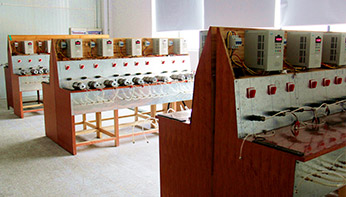The Differences between Air Cooling and Water Cooling Spindles
 Jun 24, 2024|
Jun 24, 2024| View:62
View:62I. Introduction
In the modern field of mechanical processing, the spindle, as a key component, its performance directly affects the accuracy, efficiency, and quality of processing. Air cooling and water cooling spindles are two common cooling methods, and there are significant differences in their working principles, performance characteristics, and applicable scenarios. Understanding these differences is crucial for choosing the appropriate spindle cooling method to meet specific processing requirements.

II. Comparison of Working Principles
The air cooling spindle mainly relies on a fan to blow cold air over the heat sink of the spindle to carry away heat. This cooling method is relatively simple and direct, but its heat dissipation effect is greatly affected by the air flow speed and the ambient temperature.The water cooling spindle, on the other hand, removes heat by circulating coolant flowing through the water channels inside the spindle. Due to the larger specific heat capacity of water, it can absorb more heat, so the heat dissipation effect of water cooling is usually more significant.
III. Differences in Performance Characteristics
1. Heat Dissipation Efficiency
The water cooling spindle has obvious advantages in heat dissipation efficiency. It can reduce the temperature of the spindle more quickly and effectively, thereby helping to maintain the stability and accuracy of the spindle during long-term operation.
2. Noise Level
Due to the operation of the fan, the air cooling spindle usually generates larger noise. In contrast, the operating noise of the water cooling spindle is relatively low, providing a quieter working environment.
3. Temperature Stability
Water cooling can keep the temperature of the spindle within a relatively stable range, reducing the influence of temperature fluctuations on processing accuracy. While air cooling may experience a faster temperature rise when dealing with high-temperature environments or long-term continuous work.
4. Maintenance Cost
The structure of the air cooling spindle is relatively simple, maintenance is more convenient, and the cost is also relatively low. The water cooling spindle requires regular inspection of the quality of the coolant and the circulation system, and the maintenance cost is relatively high.
IV. Analysis of Applicable Scenarios
1. Small Processing Equipment
For some small-sized equipment with light processing tasks, the air cooling spindle may be an economical choice. Its simple structure and low cost can meet the basic processing needs.
2. High-Precision Processing
In occasions that require high precision and long-term continuous processing, such as mold manufacturing, the water cooling spindle can better ensure processing accuracy and stability, and reduce the influence of thermal deformation on processing quality.
3. Harsh Environments
In harsh environments such as high temperature and high humidity, the heat dissipation advantage of the water cooling spindle is more obvious, which can ensure the normal operation of the spindle.
V. The Impact on Processing Effects
1. Processing Accuracy
The water cooling spindle performs better in processing accuracy because it can better control the temperature and reduce thermal expansion and thermal deformation.
2. Surface Quality
A stable temperature helps to improve the service life and cutting performance of the tool, thereby making the processed surface smoother and of higher quality.
3. Production Efficiency
Efficient heat dissipation can keep the spindle in the best working state and increase the processing speed and production efficiency.
VI. Selection Suggestions
When choosing between air cooling and water cooling spindles, the following factors need to be considered comprehensively:
1. Processing Requirements: Including requirements such as processing accuracy, surface quality, and production efficiency.
2. Equipment Scale and Budget: Small equipment may be more inclined to air cooling, while large, high-precision equipment may be more suitable for water cooling, but cost factors also need to be considered.
3. Working Environment: The influence of conditions such as environmental temperature and humidity on the cooling effect.
VII. Conclusion
Both air cooling and water cooling spindles have their own characteristics and advantages, and their differences are reflected in working principles, performance characteristics, applicable scenarios, and the impact on processing effects. In practical applications, the cooling method of the spindle should be selected scientifically and reasonably according to specific processing requirements and conditions to achieve the best processing effect and economic benefit. Through in-depth understanding and accurate grasp of the differences between these two cooling methods, it can provide strong support and guarantee for the development of the mechanical processing industry.









